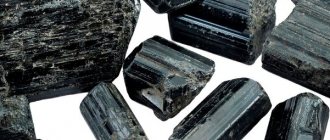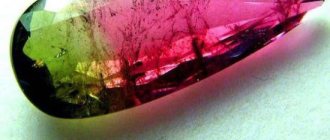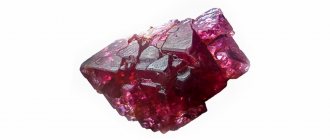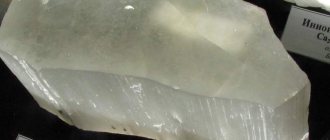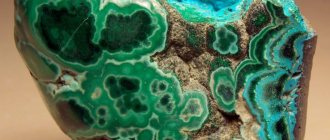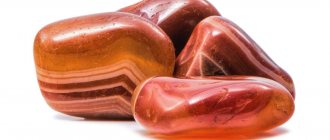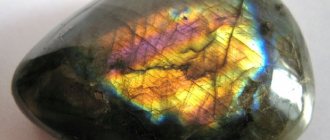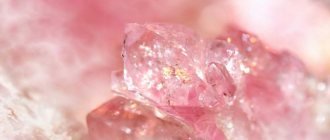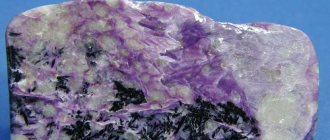Even non-precious stones can be very beautiful and have unique properties for which true collectors and specialists value them. Dravite can be classified as one of these stones. In itself, this is not an independent mineral; it is one of the existing such popular stones as tourmaline. It has many unique properties, which will be discussed below.
Colors
No gemstone has such a variety of colors as tourmaline.
And although it has been known in the Mediterranean since ancient times, tourmaline was brought to Europe from Ceylon by the Dutch in 1703. They called it the Sinhalese word “tourmali”. Along with plain ones, polychrome tourmalines are often found. In one crystal of such tourmaline, areas of different colors or shades can be distinguished. Among collectors, light-colored tourmaline crystals with a black head are called the Moor's head, and those with a red head are called the Turk's head.
Often the color distribution is zonal. In Brazil, for example, there are tourmalines with a red core, bordered first by light green, and then by dark green and green zones. South African tourmalines have a green core surrounded by a red outer zone. Collectors call tourmalines with a red core and a green “rind” watermelon.
There is probably no other such colorful stone in nature. There are many color options for tourmaline: in addition to all the colors of the rainbow, it can be black, colorless, plain and polychrome (multicolor). Polychrome crystal has different colors at the poles and can be colored in circles.
Numerology: who matches the number of the name and date of birth
The Pythagorean number, determined by date of birth, is obtained by adding the digits until a single digit number is obtained. The numbers 10, 11, 22 remain unchanged.
| What number corresponds to the letter of the name | ||
| 1 – A, L, H | 5 – D, P, I | 9 – Z, U, Z |
| 2 – B, M, Sh | 6 – E, R, b | 10 – I, F |
| 3 – V, N, Ш | 7 – Yo, S, E | 11 – J, X |
| 4 – G, O, b | 8 – Zh, T, Yu | 22 – K, C |
Example:
Yuri Gagarin, March 9, 1934
Pythagorean number by date of birth: 9+3+1+9+3+4=29=2+9=11
By first and last name: 8+6+5+11+4+1+4+1+6+5+3=54=9
Sum of date+first name+last name: 11+9=20=2
Numbers: 11, 9, 2
For tourmaline, the Pythagorean number corresponds to 11, for black schorl it is equal to 3. If the calculation results in such values, this is your stone.
Varieties
The main varieties have their own names:
- rubellite - red, ruby red is especially valued;
- verdelite - green, emerald green is especially valued;
- dravite - brown: from yellowish-brown to dark brown;
- indigolite - blue and light blue;
- achroite - colorless, rare;
- sibirite - crimson, lilac-red, red-violet;
- sherl - black;
- watermelon tourmaline - with a red core and a green border.
Tourmaline cat's eye comes in different colors, but only the green and pink varieties have a clearly visible streak of light. Its appearance is due to inclusions of fibrous minerals. Some tourmalines slightly change color when exposed to artificial light.
History of Dravite
Historically, this mineral was first found near the city of Dravograd, near the Drava River in the northern part of modern Slovenia. It is from this that the name of this material came. It was described in the scientific literature by the famous mineralogist from Austria Gustav T. von Seisnegg.
In the Russian Federation, this mineral is usually found in the Urals, in its middle part. The world's most beautiful version of this stone, dravite, which has a bluish-white hue, was discovered in the southern part of the Urals. In addition, stones are mined in Altai and Karelia.
In addition, this mineral can be found in its historical homeland in Slovenia, in the southern regions of Austria, Sri Lanka, Algeria and Kenya. China is famous for its green variety of stone, which also has the so-called “cat’s eye” effect.
The most impressive minerals in terms of size are mined in Australia, where a truly gigantic gold-colored dravite was found. Also, very large stones are supplied by Brazil, which is the undoubted leader in the number of tourmalines mined per year. The color of Brazilian stones is mainly brown.
Properties
When a crystal is heated or squeezed or rubbed, it creates an electrical charge.
In this case, one end of the crystal is charged positively, and the other - negatively. Such an electrified crystal attracts dust particles and small pieces of paper (pyro- and piezoelectricity). The Dutch sailors and merchants who first brought this mineral to Europe knew and used this effect.
They cleaned their meerschaum pipes with heated tourmaline crystals, and therefore called this stone “aschenzier” - drawing out ash.
Areas of application
The unique property of a crystal to carry an electric charge is used in radio engineering.
Tourmalines are very popular among collectors.
The ability of crystals to carry an electrical charge is widely used by Western and Eastern manufacturers. And my God, where they don’t “insert” tourmaline. This:
- belts and bandages (on the knees, on the neck, on the lower back);
- bed sheets;
- socks and underwear;
- massage mats;
- dishes;
- bath balls;
- hair combs.
Jewelry beauty
And here is a little about jewelry art.
At the beginning of the 14th century. Jewelry art is developing in Europe, the masterpiece of which was the “Crown of Charles IV”, converted in 1346 from the crown of St. Wenceslas, the enlightener of the Czech Republic. It is decorated with unique polished stones: pink tourmaline weighing 250 carats; 2 Ceylon sapphires weighing 330 and 280 carats. and 17 sapphire cabochons weighing from 200 carats; 45 red Badakhshan spinels, the largest of which weighs 100 carats; 26 emeralds from Egypt, 20 pearls and an aquamarine.
A huge (over 100 grams in weight) pink tourmaline was purchased in Beijing. Of course, it went to the first lady of Russia, Catherine I. The gem adorned the empress’s crown. When she was replaced on the throne by Anna Ioannovna, the stone from Catherine’s crown was taken out and inserted into the crowns of the new empress. New broom, whatever you want...
The leaders of the Russian Orthodox Church respected the gem. The tabernacle with a large pink crystal (it belonged to the Annunciation Cathedral of the Kremlin) is now kept in the Armory Chamber.
A red stone the size of a pigeon's egg, which King Gustav of Sweden gave to Empress Catherine II in 1777. It was believed to be a ruby. However, research has shown that it is a pink tourmaline weighing 250 carats. Currently located in the Diamond Fund in Moscow.
Selling jewelry with tourmaline
Tourmaline produces such bright jewelry that it invariably lifts the mood of its owner, and in combination with other colored stones it is a real kaleidoscope of colors. In the MUZ collections you will find rings and earrings with tourmaline and colored enamel; you can also order a pendant with this stone in the online store miuz.ru.
How to distinguish natural tourmaline from a fake Tourmaline is usually imitated using glass of different colors and various types of synthetic garnets, as well as other materials that are similar in their external characteristics.
You can distinguish a natural stone from glass by holding a sample in your hands: the glass will quickly heat up, and real tourmaline will remain cold longer.
An easy way to spot a fake. All natural tourmalines have a pronounced property - the ability to become electrified. This is an excellent diagnostic method: rub the stone on natural woolen fabric, and then bring it, for example, to finely cut pieces of paper - they should be attracted.
Paraiba tourmaline has a neon blue glow; the stone sparkles even at dusk. And if you expose a cut stone to the sun’s rays, it begins to “burn” so that it does not provide shade. However, it is very rare and expensive, so it is unlikely that you will find jewelry with it.
The meaning of dravite in astrology
All astrologers unanimously believe that tourmaline and, accordingly, all its varieties, which include the stone in question, are quite capable of being a personal amulet for almost all zodiac signs. Only Aries will not be entirely happy with the possession of such a mineral. The greatest effect is brought to those signs that can be attributed to the following elements: Water and Air. Accordingly, Libra, Gemini, Aquarius, Cancer, Pisces and Scorpio can be confident that they are protected by this amulet.
Tourmaline: magical properties of the stone
The properties of tourmaline depend on its color:
- Black. It sharpens perception, attracts inspiration, drives away self-doubt, and neutralizes negative emotions. Perfect for representatives of creative professions. Among the zodiac signs, it is best suited for power-hungry Leos and restless Scorpios.
- Pink. Allows the owner to remain young at heart regardless of age, helps to love himself and attract the love of the opposite sex. Suitable for Capricorns.
- Red. A talisman for creative individuals, helps to harmonize relationships in couples. Recommended for Aries.
- Watermelon (red-white-green). It awakens harmony with the world and compassion in a person, helps to heal mental wounds, and teaches the owner to rejoice under any circumstances. Will help Virgos, Geminis, Capricorns.
- Green. It is considered one of the most powerful stones of the heart chakra and a protector from any kind of negative influences. Such a talisman can be chosen by Gemini, Libra and Aquarius.
- Blue. Helps the owner develop spiritual qualities. Taurus, Sagittarius and Aquarius should take a closer look at blue tourmaline.
But you should not wear jewelry with sherl all the time - it is believed that it absorbs a lot of negativity, so it should be given a rest.
STRUCTURE
The syngony is trigonal; ditrigonal-pyramidal c. With. L33P. A characteristic structural unit in tourmaline is two-story (unlike beryl) ring anion radicals with the formula A12O30 where half of the A ions are Si4+, and the other half are Al3+ and B3+ ions. In this case, silicon ions in a quadruple environment of oxygen ions occupy one layer (floor) in the specified anionic radical, forming six-membered rings of a ditrigonal configuration, having a triple axis and three mirror symmetry planes passing through it. The second layer of each paired ring is represented by Al3+ and B3+ ions, located in a tetrahedral environment of oxygen ions and together with them forming a shape that is generally close to a triangle. These isolated two-story rings are located at the vertices of the rhombohedral unit cell and are connected to each other using Mg and Al ions (but in six-fold coordination of oxygen ions). These ions, being connected to each other by common oxygen ions, form helical chains in the crystal structure along the right and left triple helical axes of the rhombohedral cell. As for the Ca and Na ions, they, being in a sixfold environment of oxygen ions, are located on the same triple axes on which the paired anion rings sit, and thus connect them along the axis.
The healing properties of tourmaline
Depending on its color, certain medicinal properties are also attributed to this mineral. Thus, it is believed that watermelon tourmaline restores the nervous system. Pink stones have a beneficial effect on the endocrine and respiratory systems and heal the skin.
Green tourmaline works well with fears, helps strengthen the nervous system, has a positive effect on vision, cardiovascular and immune systems, and promotes slimness. Areas of influence of blue stones are the respiratory organs, eyes, immune system, brain, endocrine glands.
MORPHOLOGY
Tourmaline crystals usually have a columnar appearance and are elongated along a triple axis of symmetry. Occasionally, short-prismatic crystals are found. As a rule, the crystals are small, often microscopically small, but sometimes large specimens are found, up to 20 cm or more in length and several centimeters in diameter. The most common shapes are prisms {1010} and {1120}, trigonal pyramids {1011}, {0221}, etc. In total, about 180 simple shapes have been identified. Often the ends of the crystals are not equally developed. Very often observed on the faces of prisms are vertical shading, which is very characteristic of tourmalines, and an equally characteristic shape of spherical triangles in cross section (Fig. 310), due to the combination of numerous faces of the prismatic belt. Doubles are very rare according to (1011). Aggregates. Tourmaline is often observed in columnar, radial (in the form of the so-called tourmaline sun), tangled, needle-shaped or fibrous aggregates. Less common in solid granular, sometimes cryptocrystalline masses.
